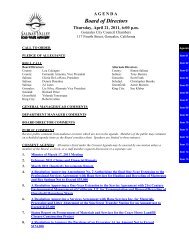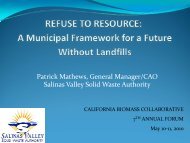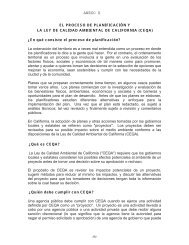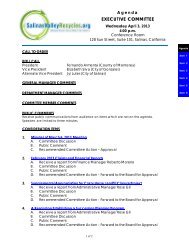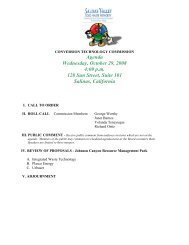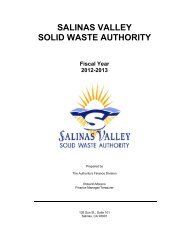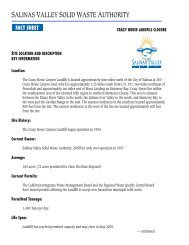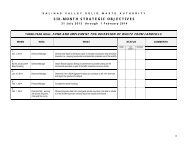revised final closure plan - Salinas Valley Solid Waste Authority
revised final closure plan - Salinas Valley Solid Waste Authority
revised final closure plan - Salinas Valley Solid Waste Authority
Create successful ePaper yourself
Turn your PDF publications into a flip-book with our unique Google optimized e-Paper software.
Revised Final Closure Plan July 2010<br />
Crazy Horse Sanitary Landfill -11- 103-97133<br />
The <strong>final</strong> cover above is an engineered alternative <strong>final</strong> cover consistent with 27 CCR 20080. In May<br />
2010, the SVSWA constructed a test pad of the proposed cover system. The Construction Report<br />
documenting the results of the test pad is provided in Appendix N.<br />
The <strong>final</strong> cover for the current recycling and maintenance area will be asphaltic concrete (AC)<br />
paving. The AC paving will provide a functional <strong>final</strong> cover while providing usable space for<br />
SVSWA and county use.<br />
Foundation Layer - Title 27 CCR §21090 stipulates that not less than two feet of a soil foundation<br />
layer shall be constructed for the <strong>final</strong> cover, unless it is shown that differential settlement and<br />
ultimate land use do not adversely affect the integrity of the <strong>final</strong> cover. Post<strong>closure</strong> use for the site<br />
will be as a solar power generation facility on the topdeck (Figure 4A). The remaining areas will be<br />
non-irrigated open-space. The ultimate land use does not involve structures or other uses of the<br />
covered areas that could be affected by differential settlement.<br />
To support vehicle travel on the closed facility during construction activities and the post<strong>closure</strong><br />
period, the foundation layer beneath traveled roadways will be a minimum of two feet thick. The<br />
SVSWA recently conducted a survey of existing foundation soil thickness. It was determined that<br />
onsite soils are available for foundation layer construction, however, it is anticipated that some soil<br />
will require import. Other surfaces of the landfill will be constructed with a minimum 1-foot thick<br />
foundation layer in the <strong>final</strong> cover system as discussed below.<br />
Low-Permeability Layer - The proposed low-permeability hydraulic barrier layer is provided by<br />
geosynthetic materials (structured LLDPE geomembrane). These geosynthetic materials can tolerate<br />
substantially higher strains up to 10 to 20 percent or greater before yielding, and thus are a superior<br />
cover construction material. Because these materials can tolerate strains 10 times larger than soil<br />
components without adverse impacts, the two-foot foundation layer thickness supportive for<br />
construction of a clay liner is not required for geosynthetic materials. Furthermore, modern<br />
landfilling techniques focus on achieving a high degree of compaction to optimize airspace, and large<br />
containers are typically diverted from the landfill that could otherwise collapse and cause large<br />
differential settlements. As a result, differential settlements at the top of the refuse are expected to be<br />
relatively small at approximately 2 percent or less (Appendix B). Therefore, the foundation layer for<br />
the proposed EAD cover design need only be thick enough to provide a clean, firm surface for the<br />
geosynthetic materials.<br />
Due to the SVSWA’s efforts and practices to divert large appliances/containers from the landfill, the<br />
development of large differential settlements resulting from large voids is considered unlikely. In<br />
addition, the SVSWA is considering utilizing dynamic compaction techniques on the finished topdeck<br />
surface to reduce settlement impacts on the constructed <strong>final</strong> cover. However, a very conservative<br />
analysis was completed that considered the potential development of a void in the underlying wastes<br />
(Appendix B). This analysis indicates that the resulting strain (2%) are well within the limits that can<br />
be tolerated by the proposed cover materials in the unlikely event that significant voids develop<br />
beneath the cover system. For the CHLF, a foundation layer of one foot is more than sufficient to<br />
achieve this objective and will also reduce the traffic and environmental impact of transporting<br />
additional foundation layer material to the site.<br />
For unlined and lined areas, the low-permeability layer will be a geomembrane placed on the<br />
foundation layer. The geomembrane exceeds the permeability requirement in 27 CCR as discussed in<br />
Appendix D.<br />
Golder Associates



